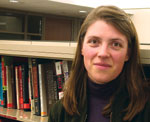 |
 |
| Switch. Dossick (bottom, center) says her dance career supported her new role as engineering teacher. (Photo top by Tom sawyer for ENR; bottom courtesy of Carrie Dossick) |
While Coeur dAlene, Idaho, and Seattle, Wash., are not that far apart in miles, the distance for Carrie (Sturts) Dossick is huge in terms of career path traveled. Still, the dancer-turned-engineering professor sees a link between her two very different passions.
By age three, Dossick had already started ballet, tap and modern dance in a dance company in her native Coeur dAlene, likely thinking thats what she would do when she grew up. Today, at age 32, she is a Ph.D. civil engineer and an assistant professor in Seattle at the University of Washingtons Dept. of Construction Management. And even with her technical bent, dance is still in the picture.
Even as a young performer, Dossick had already danced her way onto college campuses across the U.S., so traveling to New York City to attend Columbia University wasnt such a big deal. Despite the lure of being in a city of performing arts, she did not immediately choose to be a dance major, opting instead to rely on her strength in art and math to specialize in architecture with dance as a minor.
Even so, dance occupied much of her time, between classes at adjacent Barnard College and organizing Columbias "Orchesis," a student-run dance company that exists on other campuses across the U.S. Columbias group now has 200 members and is one its most popular student activities, Dossick says.
As for her major, Dossick was finding it increasingly hard to relate to the "art" in architecture without understanding the "science" of working with building materials. So she approached Columbias civil engineering department and was persuaded to switch majors, despite having no critical science prerequisites such as physics and chemistry.
Even as her engineering commitments grew, Dossick began studying with an Alvin Ailey dance troupe and entertained thoughts of joining a professional company. She also took on new choreography duties. But afraid that a dancers life was too "focused," Dossick opted to pursue advanced civil engineering degrees. "Civil engineering was a good fit for my personality," she says. "My friends didnt even see the switch coming."
Dossick took her new Ph.D. into the corporate world, working for two different California engineers, Parsons Corp. and Exponent Failure Analysis, a Menlo Park, firm that analyzes building and material failures.
She also multi-tasked by marrying a Columbia University computer science Ph.D. along the way. When her husband last year landed a job with Microsoft in Bellevue, Wash., Dossick sought an adjunct teaching job at the University of Washington. The school offered her a full-time job instead, which began last summer.
Dossick credits the dance experience with strengthening her engineering and research abilities. "I needed the creative side of my brain to feed the technical side," she says. "There are a lot of parallels between the visual organization and leadership I gained in dance and being a construction manager on site." Dossick says both disciplines involve managing materials, people and equipment. "Without it, the show doesnt go on," she says.
Going forward, there may be new creative links between Dossicks pursuits. Her engineering research focus at the university is on 3D construction visualization and animation. At the same time, she is taking new dance classes and has joined a Seattle-based dance company.
